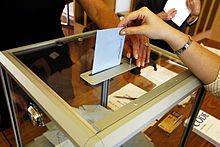U. S. Government/Elections

The election of public officals involves two steps. Candidates are first nominated by party members in primary elections. These elections are usually held in the spring. In the fall, a general election is held that pits candidates of the various parties against one another. The president of the United States is elected in a general election every four years.
For many years, candidates were selected by party leaders. Due to the efforts of reformers, however, this practice was replaced by the direct primary in the early 1900s. Nominees who sihed to become their party's candidate for a particular offfice get their name on the ballot by either filling a statement or by obtaining the required number of signatures on a petition. Voters within a party then select the nominee they think will make the best candidate.
There are two kinds of primaries: The open Primary and the closed Primary. In the open primary, voters can decide on election day which party's primary they want to participate in. They can even vote in both primaries. For example, a person can vote for a governor on the Democratic Party's ballot and vote for a candidate for a different office on the Republican Party's ballot.
The most common type of primary is the closed primary. In the closed primary, a person registered as a member of particular party can vote only in that party's primary. Most states use the closed primary today.
Some states hold presidential primaries. In these elections, voters choose delegates who are then instructed to vote for the candidate of the voters' choice at the party's national convention. However, some presidential primaries are no more than preferential primaries. In a preferential primary, voters simply express their preference for President.
See also U. S. Government/Elections/Role of Media in Elections and Governments
